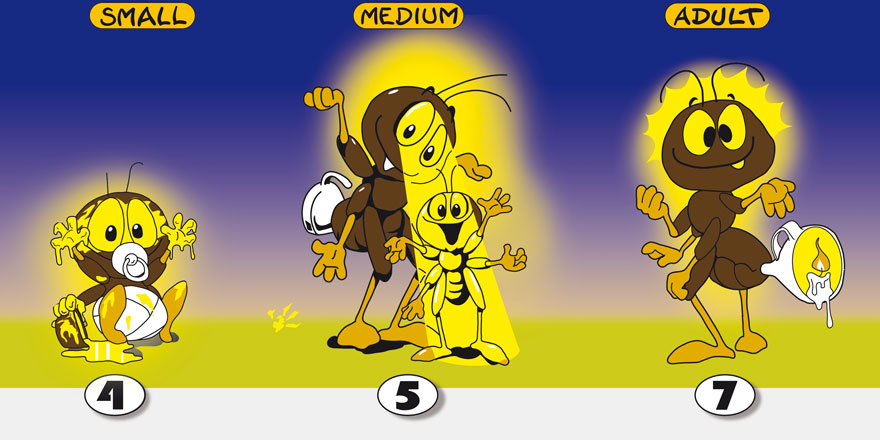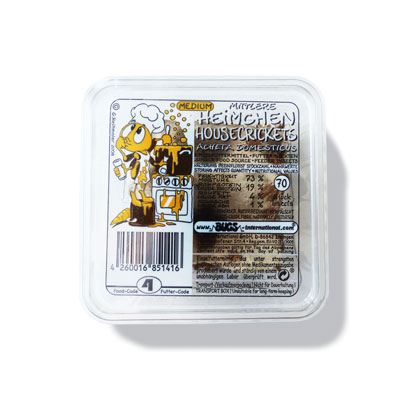
Yellow-eyed crickets (Gryllus bimaculatus)
Text: Heiko Werning
At BUGS-INTERNATIONAL, we are not only the largest breeder of feeder animals in Europe, but as a small „thank you“ for our success, we have introduced our own, new feeder animal in pet keeping. For the dietary needs of our reptiles, amphibians, birds, small mammals, invertebrates and fish, we cannot offer enough variety. Today, the diet for most of the well cared for terrarium animals and other insect-easting pets mainly consists of various types of crickets. And compared to how it used to be, the selection is not bad: Alongside the standard house cricket and Mediterranean field crickets, Jamaican field crickets and short winged crickets also belong to the established product range of every local pet supply store. But there is a lot more! Ladies and gentlemen, step right up and take a look at our newest member of the BUGS-INTERNATIONAL family:
the yellow-eyed cricket!
The yellow-eyed cricket combines the positive characteristics of the Jamaican field cricket and the Mediterranean field crickets in an ideal way. It is as big and strong as a Mediterranean field cricket, but it remains as quiet and sociable as the pleasant Jamaican field cricket. With its yellow eyes, it reflects its own colourful appeal – you see, if our terrarium dwellers know when something is worth eating. The yellow eyes of the yellow-eyed cricket stand in stark contrast to their black and dark brown bodies and will cause your mammals and other terrarium dwellers to stand up and take notice.
Based on their size, yellow-eyed crickets cover the entire range: from the ant-sized young insects – which represent an excellent source of energy for small terrarium dwellers and all types of offspring – to the large, robust adult insects that are enough to adequately feed the largest terrarium dwellers, hungry small mammals and larger birds. Large yellow-eyed crickets are therefore ideal feed for animals for which house crickets may not always be enough.
Even though yellow-eyed crickets are nocturnal, they are not light sensitive insects. They are even less likely than Mediterranean field crickets to hide in the terrarium; they also rarely try to escape an approaching predator, who already begins salivating at the sight of these crickets.
-
Adult yellow-eyed crickets can reach a body length of up to 3.5 cm; they are truly massively built and with the Mediterranean field crickets are among the biggest fish amongst the standard crickets used for feed. Both sexes are metallic black; the jumping legs are usually chestnut brown. The tops of the adult cricket‘s wings also shine in the same brown-coloured tone. With the small „teeth“ attached to the wing, the males can achieve a resounding chirping sound by rubbing them together; the do not have to play second fiddle to the Mediterranean field crickets in any regard and can create a wonderful holiday mood that reminds one of warm summer nights. The wing tops of the male are harder and more stable; this can certainly be recognised relatively quickly. A gender difference that is even more prevalent is the 2 cm long laying stinger of the female. No, don‘t worry: The crickets cannot sting or even prick with the laying stinger, which is solely used to inject the eggs into the ground.
And, of course, there is the most prominent characteristic – the eyes, which is the reason they are called „yellow-eyed crickets“. The eyes are a colourful yellow and are in sharp contrast to their black body. This makes the feeder animals quite noticeable and simultaneously appetising. But even big crickets start small. The freshly hatched babies are only 3 mm long and resemble ants. And they are also nice and black, which makes them very appealing for all ant-eating animals.
In between, the young crickets run through several stages of growth which make them the ideal source of food for a wide spectrum of terrarium dwellers, birds, fish and small mammals. There is something for everyone!
The natural range of the yellow-eyed cricket is quite small. It is in Irsingen-Unterfeld in the beautiful Bavaria. This is where the animals live in their original habitat and enjoy life on a day in, day out basis. Namely in the halls of BUGS-INTERNATIONAL.
In fact, the millions of yellow-eyed crickets that are alive today are the product of six individual crickets that BUGS founder Georg Reitmaier found amongst his Mediterranean field crickets one day. The good-looking animals caught his eyes and he separated them from the other crickets and breed them. And as it sometimes happens, when we start looking after an insect at BUGS-INTERNATIONAL: The population of the yellow-eyed crickets exploded until they were included amongst the feeder insects sent to the pet stores and, ultimately, sent to you. And you already know the rest of this story.
-
At BUGS-INTERNATIONAL we spend the entire year sparing no expenses in order to produce and always have available lively yellow-eyed crickets. The correct temperature. Light. A diet engineered by conducting hundreds of tests over the course of many years using our secret recipe – and of course only made from feed that does not contain any additives. Growth hormones, hormones and medication are unfortunately not permitted; contaminants and pesticides are of course also not permitted. So that we can be certain that this is really the case, we let entire feed groups run through an independent laboratory test to ensure that no harmful substances or undesired residues are left behind.
And then there is the most important challenge: cleanliness!
Our cricket breeding beds are cleaned and polished every day and several times during a cycle using our highly modern industrial washing systems. They are sterilised at high temperatures and thereafter they are disinfected. Not even individual microbes can survive that. The sponges we use to water our insects, as well as the bowls and cups used go through the same handling process. That goes without saying.
We never give germs any chance to multiply: In their breeding containers, the crickets live on egg cartons that offer them a place to move around and to hide. Of course, we only use new egg cartons, since even eggs can distribute diseases such as salmonella poisoning.
And this is the same process by which we put the yellow-eyed crickets into the retail boxes: with a freshly manufactured egg carton and a delicious picnic for the trip.This is the very reason why, through the entire year the insects supplied by BUGS-INTERNATIONAL are top fit and healthy, not only to your satisfaction, but also that of your terrarium dwellers.
-
Advantages of yellow-eyed crickets as feeder animals:
• Even larger insect-eating predators satisfy their appetites with adult yellow-eyed crickets
• Not jumpers
• Do not hide during the daytime
• Also suitable for slower animals
• Can be kept for a longer period of time
• Excellent nutritional value
• Change of pace due to unique appearance
• The contrast-rich colour has an irritating effect on the predators
DIsadvantages of yellow-eyed crickets as feeder animals:• Loud chirping
• Are not eaten by all animals due to their hard and resilient shell as well as their distinct aroma
• Tend to remain inactive for longer periods of time and, as a result, are not immediately recognised as food
-
We keep our own fleet of vehicles in order to transport the yellow-eyed crickets as quickly as possible for our breeding location to your local retailer or pet store. Well insulated, since yellow-eyed crickets are very susceptible to low temperatures. And they do not like it when it‘s too hot, either. Therefore, all of our vehicles are climate-controlled. Of course, that‘s standard process for fresh goods. The rest is up to you. The crickets can survive in their transport boxes for a few days. However, it is best if you pick up your feeder animals directly after they have arrived at your local pet store.
At home, please ensure that the yellow-eyed crickets are not stored at temperatures under 20 °C. Offer them fresh air and exercise. Use a so-called „Fauna box“ for each cricket size; it works wonders. You can purchase these cheaply from your local pet store. Add egg cartons or cellulose towels – and then it is home sweet home for the yellow-eyed crickets.
A good location for the cricket boxes is in a small lockable room. Very clever terrarium owners even construct a small, lockable feeding insect cabinet that can be insulated with Styrofoam. That doesn‘t just retain the heat, but also mutes the chirping sound significantly, just in case you are not in the mood for year-round holiday feeling.One more thing about the temperature: This should be adjusted based on how big you really want your crickets to get. For values in the lowest segment (approx. 20 °C) they grow slowly; at 30 °C, significantly faster. The temperatures should not rise above this.
The yellow-eyed crickets like it when it‘s warm and dry. However, dry does not mean that we should let the critters dehydrate! Otherwise, your feed will quickly be singing the blues. Providing water is very important. However, open water dishes, bird baths and similar contraptions are unsuitable. These objects can be death traps for some of your insects, or even worse: they can quickly wet the entire container. Yellow-eyed crickets can‘t stand it!In other words: a small dish in which you can place a moist cotton pad is the perfect solution. If the cotton is changed on a daily basis and replaced by a new, clean and nicely moistened piece of cotton and if the dish is also cleaned regularly, then the cricket motel with full room and board is perfect.
All that is left is to provide the yellow-eyed crickets with an adequate meal. Your animals should not have to deal with eating skinny, undernourished crickets, but instead thick and juicy crickets filled with nutrients. Don‘t be shy about offering „all you can eat“ – a little food should also be available in the cricket box. But wait. Don‘t simply just lump together mountains of food, otherwise it gets disgusting, even for the crickets. Crickets love dog flakes, fish flake food or even cereal mixes. Best bet is you always use „organic“ food, since the residues of pesticides and the insects themselves do not get along very well.
The yellow-eyed crickets can regulate their moisture requirement through plants foods. They will „pig out“ on any type of vegetable or fruit that is offered to them. However, this type of moist food also contains risks: contaminants, insecticides and other substances that do not agree with an insect‘s stomach are unfortunately no stranger to some of the foods we find in our supermarkets. Furthermore, moist foods should always be offered carefully in order to avoid the previously mentioned paludification. Using dry foods and the cotton water dish, the crickets will be happy campers and providing this type of housing for your crickets is also much more hygienic.
Yellow-eyed crickets as feeder animals The yellow-eyed crickets from BUGS-INTERNATIONAL are available in the pet store in the following sizes: small, medium and large.
Due to their wide size spectrum, the yellow-eyed cricket is an excellent feeder animal for practically all insect-eating pets. The firmness of the grown cricket is like a juicy steak to all larger sized terrarium dwellers, from the small monitor lizards to the bearded dragon and the large skinks, common tree frog, leaf frog and South American horned frogs, but also for insect-eating fish, birds, tenrecs, hedgehogs and other mammals. The ant-like cricket babies are perfect for all animals that are small themselves or enjoy eating small-sized food, in particular for animals whose diet includes ants. And the larvae stages in between satisfy the appetite of any sized insect-eating pet.
Since the yellow-eyed cricket does not move much during the daytime – as opposed to other feeder crickets – they are also very good prey for slower predators who also have the requisite jaw strength to crack the cricket‘s hard shell.
If you want to avoid that the yellow-eyed crickets run around in the terrarium at night (and begin extended chirping concerts at night), then you are best suited to feed the crickets to your predators with a tweezers. Or only put as many crickets into the terrarium as you are certain will be eaten by your animals. Of course it can always happen that a yellow-eyed crickets escapes, even if these crickets are particularly quiet and not as apt to jump around.
First the good news: You do not have to worry that the escapees will multiply in your flat or house. This won‘t happen because the demands of the yellow-eyed crickets are far too high – and that is why at BUGS-INTERNATIONAL we put so much effort into providing the best environment for the creatures! The escaped crickets will stay amongst themselves.
However: Lonely hearts will do everything they can to change their situation. The same applies to the yellow-eyed crickets. Individual male crickets chirp long and loud in the hopes of attracting a female. As previously mentioned, this chirping can also rev up the engines of the human home owners, as man and woman reflect on the hot holiday nights in faraway places. But it can certainly get on one‘s nerves.
However, there is no reason to despair: The standard available sticky traps can be used to, on the one hand, effectively limit the proliferation of the crickets in the apartment and most of the time the escaped wannabe Romeos can be easily recaptured – the Julias can also be recaptured easily. This way, the romantic field crickets can be reunited.
As ultimo ratio you can of course try insect spray, but beware: Never use insect spray in rooms where other animals are housed. And certainly not if the other feeder animals are being kept there.




